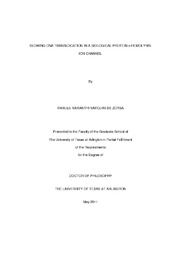
ATTENTION: The works hosted here are being migrated to a new repository that will consolidate resources, improve discoverability, and better show UTA's research impact on the global community. We will update authors as the migration progresses. Please see MavMatrix for more information.
Show simple item record
| dc.contributor.author | De Zoysa, R. Samanthi S. | en_US |
| dc.date.accessioned | 2011-07-14T20:53:38Z | |
| dc.date.available | 2011-07-14T20:53:38Z | |
| dc.date.issued | 2011-07-14 | |
| dc.date.submitted | January 2011 | en_US |
| dc.identifier.other | DISS-11054 | en_US |
| dc.identifier.uri | http://hdl.handle.net/10106/5821 | |
| dc.description.abstract | During the past decade, nanopore DNA sequencing has emerged as a revolutionary prospect towards a "$1000 genome" goal set by U.S. National Institute of Health. In the nanopore approach, electrophoretic movement of polynucleotide molecules through a nanopore would provide transient current blockades that are unique to each molecule. Since kilobase length DNA can be read directly without amplification or use of costly reagents such as enzymes and fluorescent tags, the nanopore approach can significantly reduce the sequencing cost. However, due to the rapid DNA translocation velocity through the nanopore, accurate detection of single nucleotide bases via the electrophoretically driven approach has not yet been achieved with the currently available recording technique. This dissertation work comprises of research that aim to reduce DNA translocation rate by 1) using organic salts and 2) via pH effect. In addition, nanopore detection of nerve agent hydrolytes and monitoring peptide cleavage are also included in this dissertation | en_US |
| dc.description.sponsorship | Guan, Richard | en_US |
| dc.language.iso | en | en_US |
| dc.publisher | Chemistry & Biochemistry | en_US |
| dc.title | Slowing DNA Translocation In A Biological Protein α-hemolysin Ion Channel | en_US |
| dc.type | Ph.D. | en_US |
| dc.contributor.committeeChair | Guan, Richard | en_US |
| dc.degree.department | Chemistry & Biochemistry | en_US |
| dc.degree.discipline | Chemistry & Biochemistry | en_US |
| dc.degree.grantor | University of Texas at Arlington | en_US |
| dc.degree.level | doctoral | en_US |
| dc.degree.name | Ph.D. | en_US |
Files in this item
- Name:
- DEZOYSA_uta_2502D_11054.pdf
- Size:
- 10.94Mb
- Format:
- PDF
This item appears in the following Collection(s)
Show simple item record


